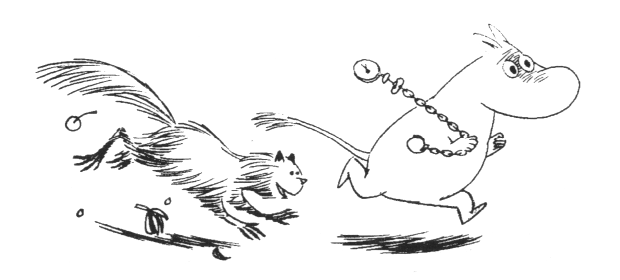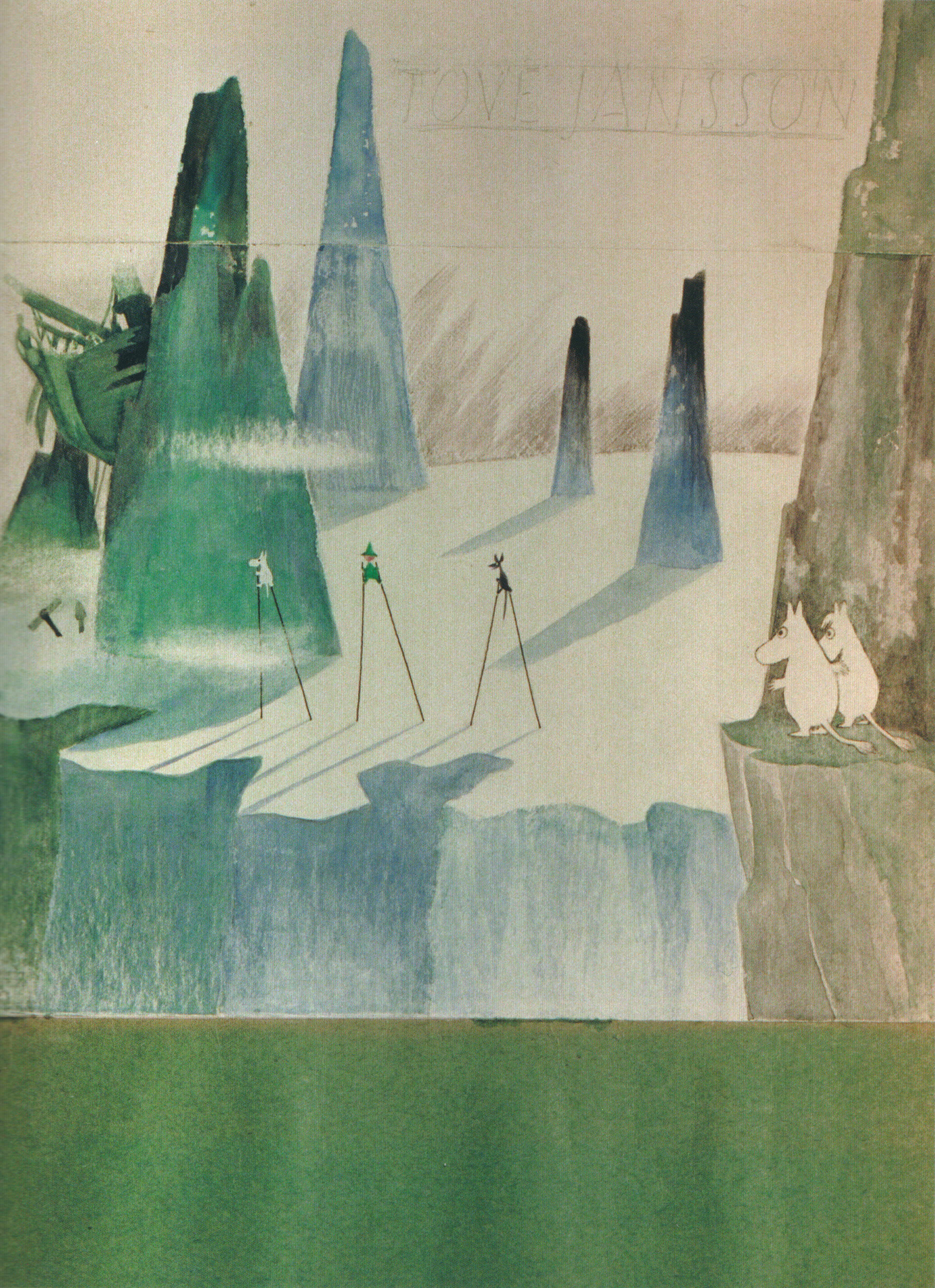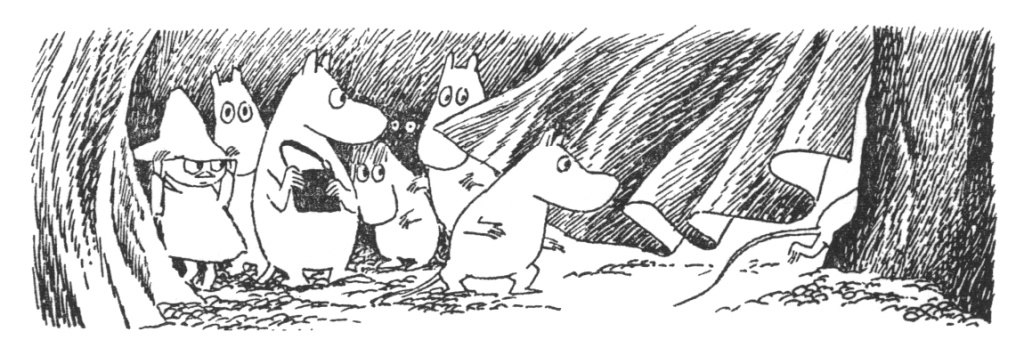Kometjakten – Mumintrollet på kometjakt – Kometen kommer
When a mysterious star appears in the sky, Moomintroll and Sniff embark on a journey to an observatory to learn more about it. Upon arrival, they find out the star is actually a comet heading straight towards the Earth. Suddenly a race back to the safety of Moominvalley begins to prepare for the end of the world.
The second book in the series, this sees the introduction of the popular characters Snufkin and Snorkmaiden, with the minor characters the Muskrat, the Snork and a stamp-collecting Hemulen reappearing in the follow-up Finn Family Moomintroll. Additionally Sniff is given a proper name after having only been referred to as the Little Creature in the previous story.
The book was greatly reworked and republished twice, changing illustrations, story details and title each time. Originally titled Kometjakten (The Comet Chase) in its initial 1946 publication, re-titled Mumintrollet på kometjakt (Moomintroll on a Comet Chase) in 1956 and finalized as Kometen kommer (The Comet Is Coming) in 1968, the last being what the title is commonly referred as in Swedish. As a result, this is the Moomin story that has gone through the most revisions over the years with lots of publication differences.
With the book gaining more traction than the preceding long out-of-print the Moomins and the Great Flood as well as defining more of the familiar characteristics of the Moomins world, this is commonly treated as the first proper book in the series. Carrying over many of the themes of the previous story, Comet in Moominland has clear contemporary connections to the second world war, in particular bomb raidings and the civilian perspective (Karjalainen, 2013, p. 142). A striking parallel could be drawn between the omni-present comet and looming threat of the newly invented atom bomb, but is rather a non-intended coincidence as the writing had already been finished by the time of the Hiroshima and Nagasaki bombings (Westin, 2007, p. 195).
Much like the book before it, Tove Jansson intended to include the word “mumin” in the original title, but wasn’t able to. The working title for the book was initially Mumintrollet och den kusliga kometen (Moomintroll and the Eerie Comet) (Westin, 2007, p. 183), before eventually being submitted as Mumintrollet och kometen (Moomintroll and the Comet), but was ultimately changed to Kometjakten by the Swedish publisher Sörlin (SvD, 1982), likely as the word “mumin” was considered too strange and imaginative. It could be assumed that Tove Jansson tried to bring forth the Moomin-centric title with both the Finnish and Swedish publishers.
The story was initially unsuccessful, with a slim distribution of 3000 copies reported for Sweden, and a presumed equal amount for Finland. By early 1948, the book had only sold 246 copies in Finland, which lead to series being dropped by publisher Söderströms (Westin, 2007, p. 200, 215). Since then, the book has been redistributed and translated to numerous languages across the world, retroactively making it a substantially larger success than during its initial distribution.
In relation to revising and reissuing the story, the illustrations changed in the process. A few remain the same from 1946 to 1968, but most are changed once or twice along the way. Most notably, all of the ink wash pieces were exchanged for more regular ink renditions in the 1951 English publication and remained as such since then. These are presented below.
Additionally, the following illustrations changed from 1946 to 1951.
These next illustrations were cut in the 1956 Swedish revision. To avoid potential confusion, it should be noted that most are still included in English publications as the book has never been retranslated according to Tove Jansson’s revisions to the story past 1951.
The largest set of redrawn or altered illustrations are from the 1968 revision. The following are all illustrations from 1946 that were updated for 1968.
The following four illustrations are the only ones that changed in every revision.
In relation to the 1968 revision, a few illustrations were cut altogether. Mostly ones related to the omitted silk monkey character.
In exchange, the 1968 added a few all new illustrations that either show the new kitten character or visualize more of what’s going on in the story.
Finally, a cut illustration presumably intended for the 1968 revision featuring Moomintroll running to shelter with the silk monkey at the end of the story. It was most likely drawn very early in the work on the revision, before Tove Jansson decided to replace the silk monkey with the kitten.
Through its many publications, the Comet in Moominland saw several cover illustrations. Pictured below are the cover artwork for the original 1946 pressing, the mainland Swedish 1946 first pressing, the 1955 Finnish translation, the 1956 revision and the 1968 revision.
There exists an additional third version of the iconic stilt walk cover, due to its strong similarities to the 1968 version it’s safe to assume this was an unused draft for that reissue.

The story of the comet was adapted by Tove Jansson twice in comic strip format, in 1948 and 1958, and once on stage for the first Moomin play. This together with the book being reworked and republished thrice makes it the one Moomin story that Tove Jansson herself went back to and adapted the most, having six different versions in total.
Sources:
Karjalainen, T. (2013). Tove Jansson: Arbeta och älska. Schildts & Söderström.
Werkelid, C. O. (28 February 1982). Den låsta vindens hemlighet. Svenska dagbladet (SvD).
Westin, B. (2007) Tove Jansson: Ord, bild, liv. Albert Bonniers förlag.

| Published: | 1946 |
| English translation: | 1951 |
| Finnish translation: | 1955 |





























































































































